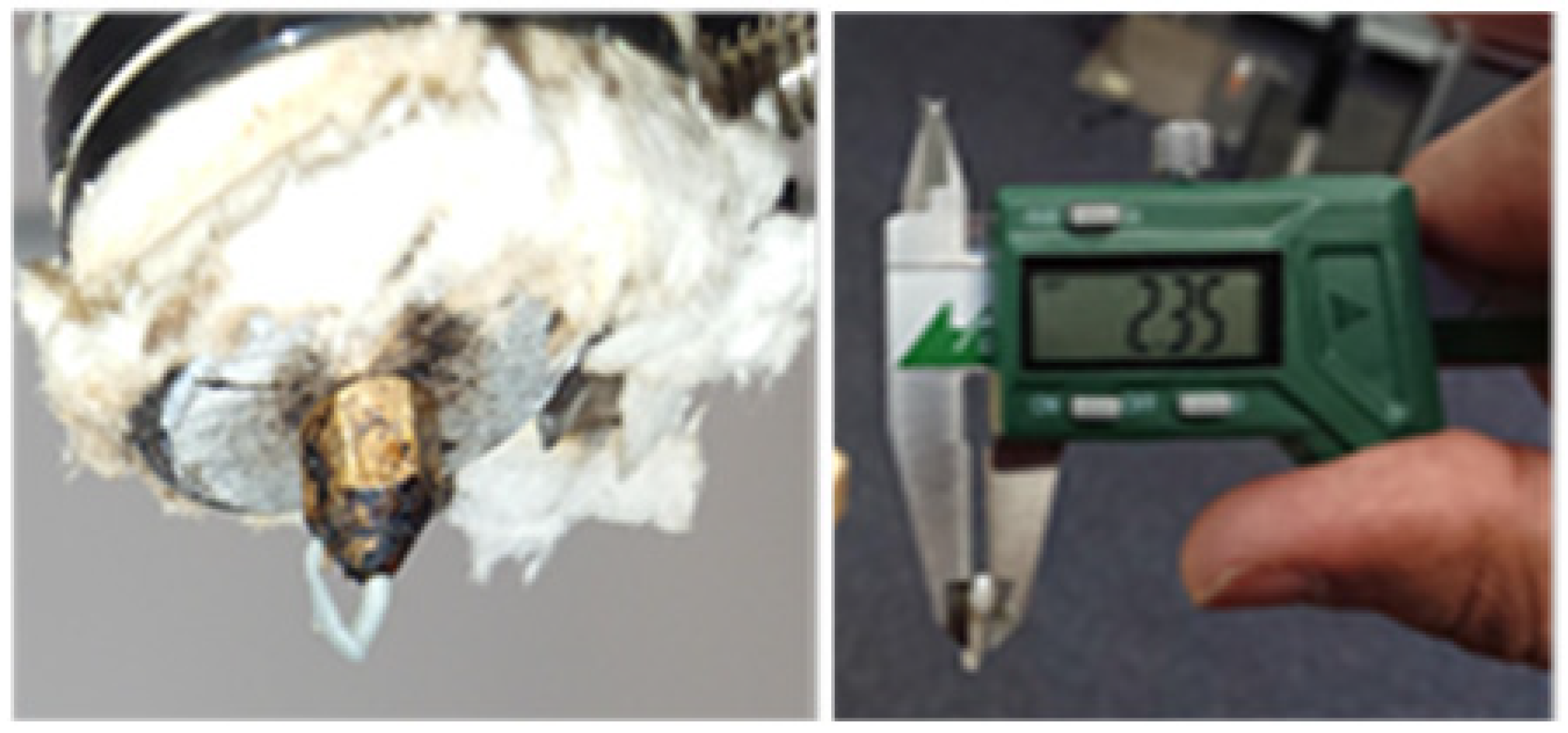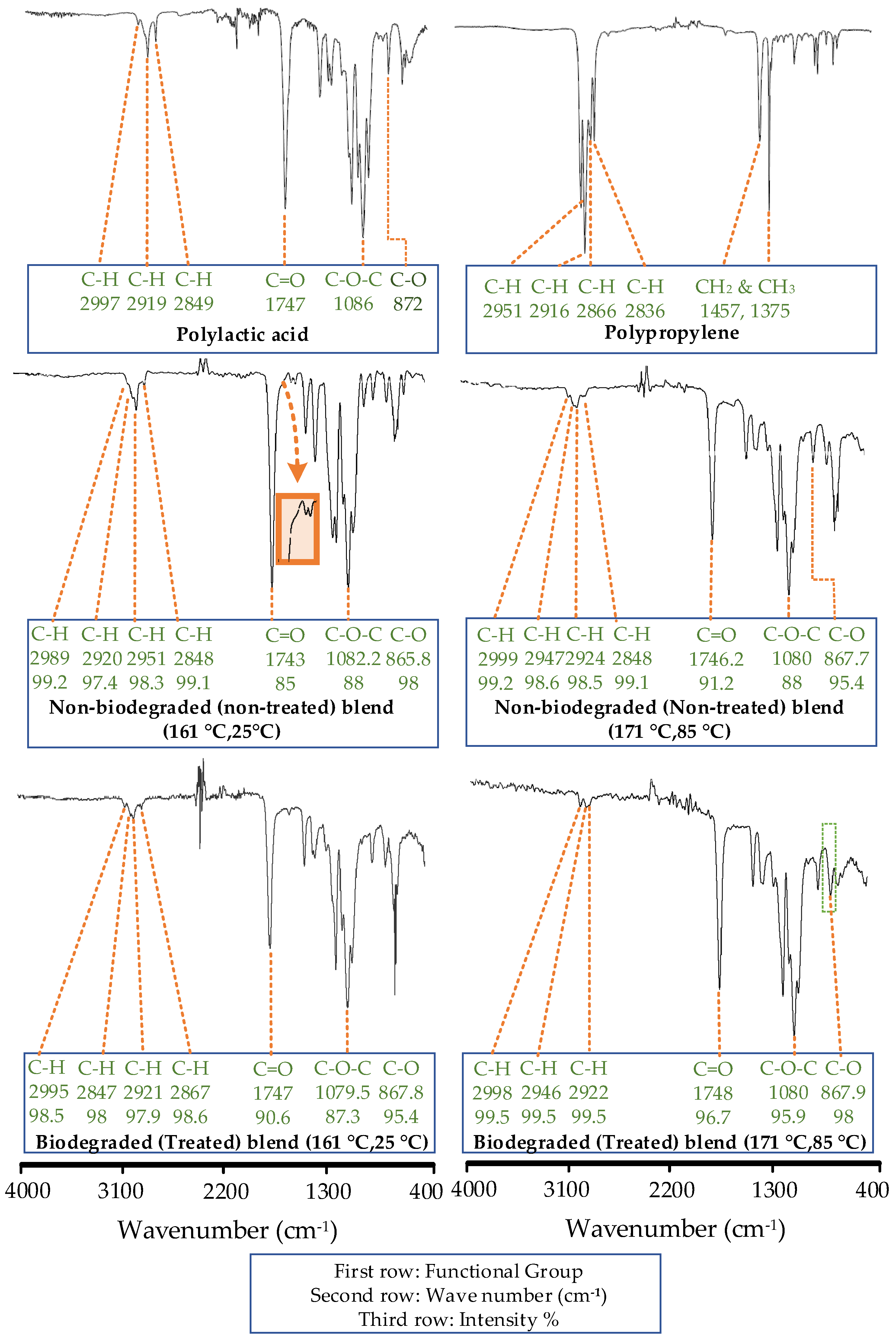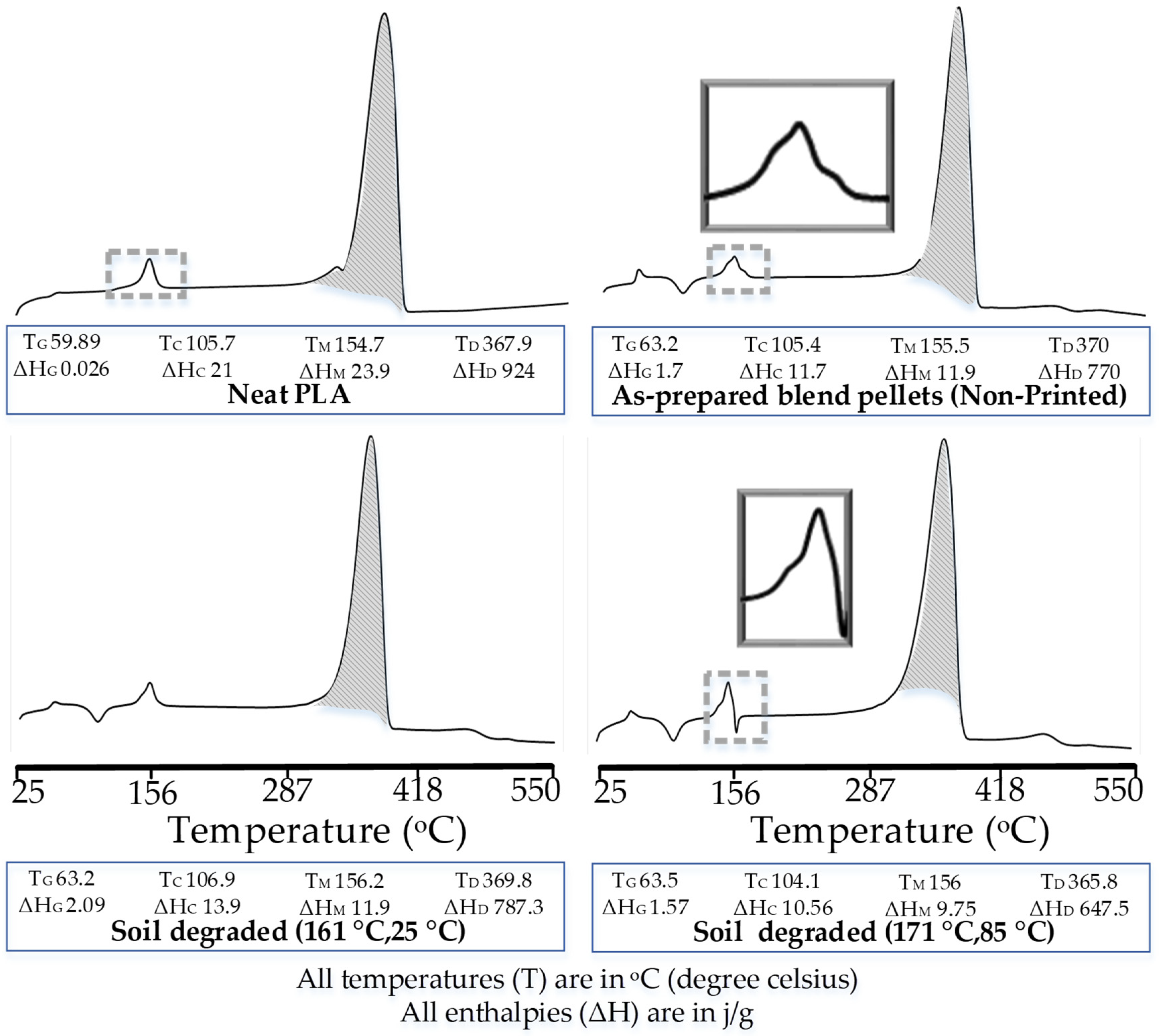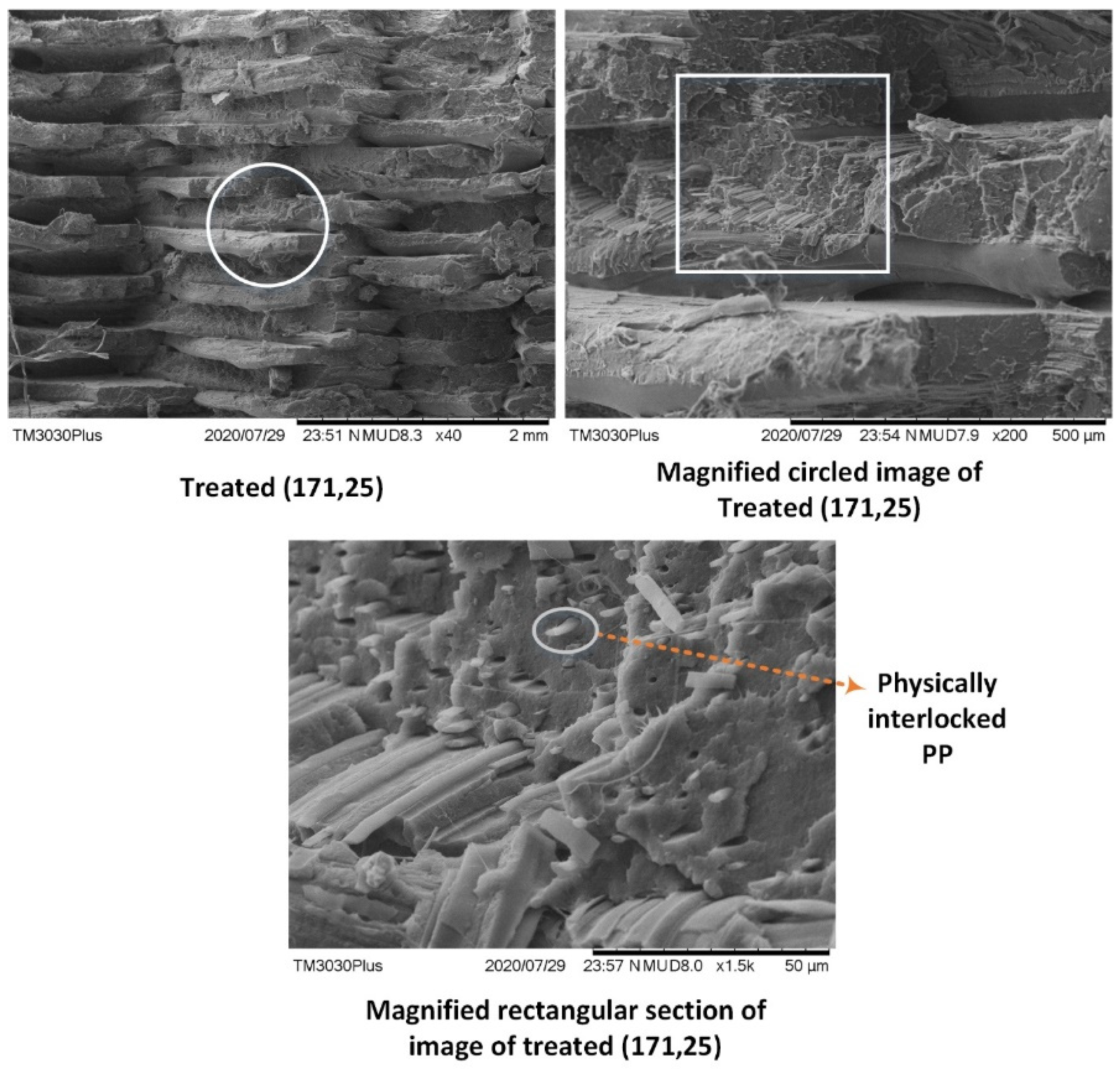Partial Biodegradable Blend with High Stability against Biodegradation for Fused Deposition Modeling
Abstract
:1. Introduction
2. Materials and Methods
2.1. Materials
2.2. Melt Blending
2.3. Pellet 3D Printing
2.4. Soil Biodegradation Testing
2.5. Mechanical Testing
2.6. Fourier Transform Infrared Spectroscopy (FTIR)
2.7. Differential Scanning Calorimetry (DSC)
2.8. Thermogravimetric Analysis (TGA)
2.9. Scanning Electron Microscope (SEM)
3. Results
3.1. Soil-Based Biodegradation on Weight Retention
3.2. Soil-Based Biodegradation on Tensile Strength
4. Discussion
4.1. Analysis for Intermolecular Interactions
4.2. Analysis for Nature of Blending and Effects of Degradation Mechanisms
4.3. Measurement of Interlocking and Chemical Grafting
4.4. Morphological Analysis Using SEM
5. Conclusions
Supplementary Materials
Author Contributions
Funding
Institutional Review Board Statement
Informed Consent Statement
Data Availability Statement
Acknowledgments
Conflicts of Interest
References
- Salifu, S.; Desai, D.; Ogunbiyi, O.; Mwale, K. Recent development in the additive manufacturing of polymer-based composites for automotive structures—A review. Int. J. Adv. Manuf. Technol. 2022, 119, 6877–6891. [Google Scholar] [CrossRef]
- Tamez, M.B.A.; Taha, I. A review of additive manufacturing technologies and markets for thermosetting resins and their potential for carbon fiber integration. Addit. Manuf. 2021, 37, 101748. [Google Scholar] [CrossRef]
- Wang, D.; Liu, L.; Deng, G.; Deng, C.; Bai, Y.; Yang, Y.; Wu, W.; Chen, J.; Liu, Y.; Wang, Y. Recent progress on additive manufacturing of multi-material structures with laser powder bed fusion. Virtual Phys. Prototyp. 2022, 17, 329–365. [Google Scholar] [CrossRef]
- Nohut, S.; Schwentenwein, M. Vat Photopolymerization Additive Manufacturing of Functionally Graded Materials: A Review. J. Manuf. Mater. Process. 2022, 6, 17. [Google Scholar] [CrossRef]
- Hu, Y. Recent progress in field-assisted additive manufacturing: Materials, methodologies, and applications. Mater. Horiz. 2021, 8, 885–911. [Google Scholar] [CrossRef]
- Mahmood, M.A.; Chioibasu, D.; Ur Rehman, A.; Mihai, S.; Popescu, A.C. Post-Processing Techniques to Enhance the Quality of Metallic Parts Produced by Additive Manufacturing. Metals 2022, 12, 77. [Google Scholar] [CrossRef]
- Cramer, C.L.; Ionescu, E.; Graczyk-Zajac, M.; Nelson, A.T.; Katoh, Y.; Haslam, J.J.; Wondraczek, L.; Aguirre, T.G.; LeBlanc, S.; Wang, H. Additive manufacturing of ceramic materials for energy applications: Road map and opportunities. J. Eur. Ceram. Soc. 2022, 42, 3049–3088. [Google Scholar] [CrossRef]
- Kristiawan, R.B.; Imaduddin, F.; Ariawan, D.; Arifin, Z. A review on the fused deposition modeling (FDM) 3D printing: Filament processing, materials, and printing parameters. Open Eng. 2021, 11, 639–649. [Google Scholar] [CrossRef]
- Della Bona, A.; Cantelli, V.; Britto, V.T.; Collares, K.F.; Stansbury, J.W. 3D printing restorative materials using a stereolithographic technique: A systematic review. Dent. Mater. 2021, 37, 336–350. [Google Scholar] [CrossRef]
- Lupone, F.; Padovano, E.; Casamento, F.; Badini, C. Process Phenomena and Material Properties in Selective Laser Sintering of Polymers: A Review. Materials 2021, 15, 183. [Google Scholar] [CrossRef]
- Ishfaq, K.; Abdullah, M.; Mahmood, M.A. A state-of-the-art direct metal laser sintering of Ti6Al4V and AlSi10Mg alloys: Surface roughness, tensile strength, fatigue strength and microstructure. Opt. Laser Technol. 2021, 143, 107366. [Google Scholar] [CrossRef]
- Żaba, K.; Tuz, L.; Noga, P.; Rusz, S.; Zabystrzan, R. Effect of Multi-Variant Thermal Treatment on Microstructure Evolution and Mechanical Properties of AlSi10Mg Processed by Direct Metal Laser Sintering and Casting. Materials 2022, 15, 974. [Google Scholar] [CrossRef] [PubMed]
- Rajan, K.; Samykano, M.; Kadirgama, K.; Harun, W.S.W.; Rahman, M. Fused deposition modeling: Process, materials, parameters, properties, and applications. Int. J. Adv. Manuf. Technol. 2022, 1–40. [Google Scholar] [CrossRef]
- Chaka, K.T. Fused deposition modeling of polypropylene-aluminium silicate dihydrate microcomposites. e-Polymers 2022, 22, 87–98. [Google Scholar] [CrossRef]
- Duty, C.E.; Kunc, V.; Compton, B.; Post, B.; Erdman, D.; Smith, R.; Lind, R.; Lloyd, P.; Love, L. Structure and mechanical behavior of Big Area Additive Manufacturing (BAAM) materials. Rapid Prototyp. J. 2017, 23, 181–189. [Google Scholar] [CrossRef]
- Shaikh, S.; Yaqoob, M.; Aggarwal, P. An overview of biodegradable packaging in food industry. Curr. Res. Food Sci. 2021, 4, 503–520. [Google Scholar] [CrossRef]
- Beniak, J.; Šooš, Ľ.; Križan, P.; Matúš, M.; Ruprich, V. Resistance and Strength of Conductive PLA Processed by FDM Additive Manufacturing. Polymers 2022, 14, 678. [Google Scholar] [CrossRef]
- Yang, Y.; Wu, H.; Fu, Q.; Xie, X.; Song, Y.; Xu, M.; Li, J. 3D-Printed Polycaprolactone-Chitosan based drug delivery implants for personalized administration. Mater. Des. 2022, 214, 110394. [Google Scholar] [CrossRef]
- Gregory, D.A.; Taylor, C.S.; Fricker, A.T.; Asare, E.; Tetali, S.S.; Haycock, J.W.; Roy, I. Polyhydroxyalkanoates and their advances for biomedical applications. Trends Mol. Med. 2022, 28, 331–342. [Google Scholar] [CrossRef]
- Tu, W.; Chu, H.; Huang, C.; Chen, C.; Ou, C.; Guo, G. Polyhydroxyalkanoate production by Cupriavidus necator with inedible rice. BioResources 2022, 17, 2202. [Google Scholar]
- Lin, C.; Liu, L.; Liu, Y.; Leng, J. 4D printing of shape memory polybutylene succinate/polylactic acid (PBS/PLA) and its potential applications. Compos. Struct. 2022, 279, 114729. [Google Scholar] [CrossRef]
- Selvamani, S.; Rajan, K.; Samykano, M.; Kumar, R.; Kadirgama, K.; Mohan, R. Investigation of tensile properties of PLA–brass composite using FDM. Prog. Addit. Manuf. 2022, 1–13. [Google Scholar] [CrossRef]
- Mandala, R.; Bannoth, A.P.; Akella, S.; Rangari, V.K.; Kodali, D. A short review on fused deposition modeling 3D printing of bio-based polymer nanocomposites. J. Appl. Polym. Sci. 2022, 139, 51904. [Google Scholar] [CrossRef]
- Chacón, J.M.; Caminero, M.A.; García-Plaza, E.; Núñez, P.J. Additive manufacturing of PLA structures using fused deposition modelling: Effect of process parameters on mechanical properties and their optimal selection. Mater. Des. 2017, 124, 143–157. [Google Scholar] [CrossRef]
- Park, K.; Xanthos, M. A study on the degradation of polylactic acid in the presence of phosphonium ionic liquids. Polym. Degrad. Stab. 2009, 94, 834–844. [Google Scholar] [CrossRef]
- Holm, V.K.; Ndoni, S.; Risbo, J. The stability of poly (lactic acid) packaging films as influenced by humidity and temperature. J. Food Sci. 2006, 71, E40–E44. [Google Scholar] [CrossRef]
- Carrasco, F.; Pagès, P.; Gámez-Pérez, J.; Santana, O.; Maspoch, M.L. Processing of poly (lactic acid): Characterization of chemical structure, thermal stability and mechanical properties. Polym. Degrad. Stab. 2010, 95, 116–125. [Google Scholar] [CrossRef]
- Rasselet, D.; Caro-Bretelle, A.-S.; Taguet, A.; Lopez-Cuesta, J.-M. Reactive compatibilization of PLA/PA11 blends and their application in additive manufacturing. Materials 2019, 12, 485. [Google Scholar] [CrossRef] [Green Version]
- Nwabunma, D.; Kyu, T. Polyolefin Blends, 1st ed.; John Wiley & Sons: Hoboken, NJ, USA, 2008. [Google Scholar] [CrossRef]
- Harris, M.; Potgieter, J.; Mohsin, H.; Chen, J.Q.; Ray, S.; Arif, K.M. Partial Polymer Blend for Fused Filament Fabrication with High Thermal Stability. Polymers 2021, 13, 3353. [Google Scholar] [CrossRef]
- Jamshidian, M.; Tehrany, E.A.; Imran, M.; Jacquot, M.; Desobry, S. Poly-lactic acid: Production, applications, nanocomposites, and release studies. Compr. Rev. Food Sci. Food Saf. 2010, 9, 552–571. [Google Scholar] [CrossRef]
- Kelly, A.L.; Brown, E.C.; Coates, P.D. The effect of screw geometry on melt temperature profile in single screw extrusion. Polym. Eng. Sci. 2006, 46, 1706–1714. [Google Scholar] [CrossRef]
- Vrsaljko, D.; Macut, D.; Kovačević, V. Potential role of nanofillers as compatibilizers in immiscible PLA/LDPE Blends. J. Appl. Polym. Sci. 2015, 132, 41414. [Google Scholar] [CrossRef]
- Kumar, K.A.; Soundararajan, S. Studies on Mechanical, Barrier, Optical and Physical Properties of LDPE/PLA Blend for Packaging Films. J. Polym. Mater. 2016, 33, 491–502. [Google Scholar]
- Hwang, K.-J.; Park, J.-W.; Kim, I.; Ha, C.-S.; Kim, G.-H. Effect of a compatibilizer on the microstructure and properties of partially biodegradable LDPE/aliphatic polyester/organoclay nanocomposites. Macromol. Res. 2006, 14, 179–186. [Google Scholar] [CrossRef]
- Yu, G.; Ji, J.; Zhu, H.; Shen, J. Poly (D, L-lactic acid)-block-(ligand-tethered poly (ethylene glycol)) copolymers as surface additives for promoting chondrocyte attachment and growth. J. Biomed. Mater. Res. B 2006, 76, 64–75. [Google Scholar] [CrossRef]
- Supri, A.G.; Ismail, H.; Shuhadah, S. Effect of polyethylene-grafted maleic anhydride (PE-g-MAH) on properties of low density polyethylene/eggshell powder (LDPE/ESP) composites. Polym. Plast. Technol. Eng. 2010, 49, 347–353. [Google Scholar] [CrossRef]
- Gao, H.; Xie, Y.; Ou, R.; Wang, Q. Grafting effects of polypropylene/polyethylene blends with maleic anhydride on the properties of the resulting wood–plastic composites. Compos. Part A Appl. Sci. Manuf. 2012, 43, 150–157. [Google Scholar] [CrossRef]
- Whyman, S.; Arif, K.M.; Potgieter, J. Design and development of an extrusion system for 3D printing biopolymer pellets. Int. J. Adv. Manuf. Technol. 2018, 96, 3417–3428. [Google Scholar] [CrossRef]
- Wallis, M.D.; Bhatia, S.K. Thermal degradation of high density polyethylene in a reactive extruder. Polym. Degrad. Stab. 2007, 92, 1721–1729. [Google Scholar] [CrossRef]
- Harris, M.; Potgieter, J.; Archer, R.; Arif, K.M. Effect of Material and Process Specific Factors on the Strength of Printed Parts in Fused Filament Fabrication: A Review of Recent Developments. Materials 2019, 12, 1664. [Google Scholar] [CrossRef] [Green Version]
- D638-10, 2010; Standard Test Methods for Tensile Properties of Plastics. ASTM International: West Conshohocken, PA, USA, 2010.
- Wang, H.; Wei, D.; Zheng, A.; Xiao, H. Soil burial biodegradation of antimicrobial biodegradable PBAT films. Polym. Degrad. Stab. 2015, 116, 14–22. [Google Scholar] [CrossRef]
- Wu, C.S. Modulation, functionality, and cytocompatibility of three-dimensional printing materials made from chitosan-based polysaccharide composites. Mater. Sci. Eng. C-Mater. 2016, 69, 27–36. [Google Scholar] [CrossRef] [PubMed]
- Ma, P.; Jiang, L.; Ye, T.; Dong, W.; Chen, M. Melt free-radical grafting of maleic anhydride onto biodegradable poly (lactic acid) by using styrene as a comonomer. Polymers 2014, 6, 1528–1543. [Google Scholar] [CrossRef] [Green Version]
- Birnin-Yauri, A.U.; Ibrahim, N.A.; Zainuddin, N.; Abdan, K.; Then, Y.Y.; Chieng, B.W. Effect of maleic anhydride-modified poly (lactic acid) on the properties of its hybrid fiber biocomposites. Polymers 2017, 9, 165. [Google Scholar] [CrossRef] [PubMed] [Green Version]
- Morent, R.; De Geyter, N.; Leys, C.; Gengembre, L.; Payen, E. Comparison between XPS-and FTIR-analysis of plasma-treated polypropylene film surfaces. Surf. Interface Anal. 2008, 40, 597–600. [Google Scholar] [CrossRef]
- Harris, M.; Potgieter, J.; Ray, S.; Archer, R.; Arif, K.M. Polylactic acid and high-density polyethylene blend: Characterization and application in additive manufacturing. J. Appl. Polym. Sci. 2020, 137, 49602. [Google Scholar] [CrossRef]
- Gajria, A.M.; Dave, V.; Gross, R.A.; McCarthy, S.P. Miscibility and biodegradability of blends of poly (lactic acid) and poly (vinyl acetate). Polymer 1996, 37, 437–444. [Google Scholar] [CrossRef]








| Blend | Biodegradable Polymer (PLA) | Compatibilizer | Nonbiodegradable Polymer (PP) | Extrudate Diameter (Must Be ≤0.2) | Decision |
|---|---|---|---|---|---|
| 1 | 75 | 5 | 20 | 2.3 ± 0.05 | Rejected and moved to next composition with less MAH and PP |
| 2 | 92 | 0.5 | 7.5 | 0.2 ± 0.05 | Successfully 3D-printed. Further compositions are not required. |
| Parameter | Set Value |
|---|---|
| Multiplier | 5 |
| Printing speed | 15 m/min |
| Bed temperature | 25 °C, 55 °C, 85 °C |
| Printing temperature | 161 °C, 166 °C, 171 °C |
| Factor (Parameter) | Level 1 | Level 2 | Level 3 |
|---|---|---|---|
| Printing Bed (surface) temperature | 25 ± 2 °C | 55 ± 2 °C | 85 ± 2 °C |
| Printing (nozzle) temperature | 161 ± 3 °C | 166 ± 3 °C | 171 ± 3 °C |
| Soil burial interval | 0 days | 45 days |
| StdOrder | RunOrder | PtType | Blocks | Bed Temperature | Printing Temperature | Soil Treatment | Tensile Strength (MPa) |
|---|---|---|---|---|---|---|---|
| 4 | 1 | 1 | 1 | 25 | 166 | Treated | 37.15 |
| 6 | 2 | 1 | 1 | 25 | 171 | Treated | 42.79104 |
| 8 | 3 | 1 | 1 | 55 | 161 | Treated | 39.53389 |
| 5 | 4 | 1 | 1 | 25 | 171 | Non-treated | 43.37669 |
| 15 | 5 | 1 | 1 | 85 | 166 | Non-treated | 32.49289 |
| 1 | 6 | 1 | 1 | 25 | 161 | Non-treated | 38.92701 |
| 18 | 7 | 1 | 1 | 85 | 171 | Treated | 38.850825 |
| 13 | 8 | 1 | 1 | 85 | 161 | Non-treated | 44.959735 |
| 17 | 9 | 1 | 1 | 85 | 171 | Non-treated | 43.10712 |
| 11 | 10 | 1 | 1 | 55 | 171 | Non-treated | 40.01403 |
| 7 | 11 | 1 | 1 | 55 | 161 | Non-treated | 42.99 |
| 9 | 12 | 1 | 1 | 55 | 166 | Non-treated | 37.71559 |
| 16 | 13 | 1 | 1 | 85 | 166 | Treated | 36.9 |
| 2 | 14 | 1 | 1 | 25 | 161 | Treated | 33.936205 |
| 3 | 15 | 1 | 1 | 25 | 166 | Non-treated | 36.12446 |
| 12 | 16 | 1 | 1 | 55 | 171 | Treated | 35.73578 |
| 10 | 17 | 1 | 1 | 55 | 166 | Treated | 37.063755 |
| 14 | 18 | 1 | 1 | 85 | 161 | Treated | 37.5 |
| Mass Loss% | PLA | Soil 161 °C, 25 °C | Soil 171 °C, 85 °C |
|---|---|---|---|
| 50% | 368 °C | 365.7 | 359.5 |
| 0.0 | −0.63 | −2.31 | |
| 60% | 372 °C | 369.1 (−0.57) | 363.7 (−2.02) |
| 0.0 | −0.78 | −2.23 | |
| 70% | 375 °C | 372.5 (−0.59) | 367.8 (−1.84) |
| 0.0 | −0.67 | −1.92 | |
| 80% | 378 °C | 376.3 (−0.50) | 372.3 (−1.56) |
| 0.0 | −0.45 | −1.51 | |
| 90% | 383 °C | 382.6 (+0.03) | 379.3 (−0.84) |
| 0.0 | −0.10 | −0.97 | |
| 92% | 384 °C | 419.6 (+9.36) | 432.5 (+12.7) |
| 0.0 | 9.27 | 12.63 | |
| 95% | 386 °C | 462.1 (+19.8) | 463.3 (+20.1) |
| 0.0 | 19.72 | 20.03 |
Publisher’s Note: MDPI stays neutral with regard to jurisdictional claims in published maps and institutional affiliations. |
© 2022 by the authors. Licensee MDPI, Basel, Switzerland. This article is an open access article distributed under the terms and conditions of the Creative Commons Attribution (CC BY) license (https://creativecommons.org/licenses/by/4.0/).
Share and Cite
Harris, M.; Mohsin, H.; Potgieter, J.; Ishfaq, K.; Archer, R.; Chen, Q.; De Silva, K.; Guen, M.-J.L.; Wilson, R.; Arif, K.M. Partial Biodegradable Blend with High Stability against Biodegradation for Fused Deposition Modeling. Polymers 2022, 14, 1541. https://doi.org/10.3390/polym14081541
Harris M, Mohsin H, Potgieter J, Ishfaq K, Archer R, Chen Q, De Silva K, Guen M-JL, Wilson R, Arif KM. Partial Biodegradable Blend with High Stability against Biodegradation for Fused Deposition Modeling. Polymers. 2022; 14(8):1541. https://doi.org/10.3390/polym14081541
Chicago/Turabian StyleHarris, Muhammad, Hammad Mohsin, Johan Potgieter, Kashif Ishfaq, Richard Archer, Qun Chen, Karnika De Silva, Marie-Joo Le Guen, Russell Wilson, and Khalid Mahmood Arif. 2022. "Partial Biodegradable Blend with High Stability against Biodegradation for Fused Deposition Modeling" Polymers 14, no. 8: 1541. https://doi.org/10.3390/polym14081541
APA StyleHarris, M., Mohsin, H., Potgieter, J., Ishfaq, K., Archer, R., Chen, Q., De Silva, K., Guen, M.-J. L., Wilson, R., & Arif, K. M. (2022). Partial Biodegradable Blend with High Stability against Biodegradation for Fused Deposition Modeling. Polymers, 14(8), 1541. https://doi.org/10.3390/polym14081541








